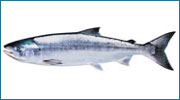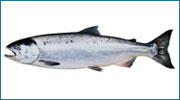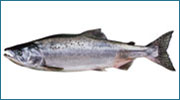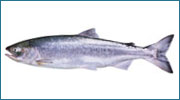Pacific Salmon Story
Pacific Salmon Story
Pacific salmon spend most of their lives traveling. They are born in freshwater rivers, swim out to the Ocean for most of their adult life and instinctively return to their natal river in time to reach the shallow waters to spawn.
There are five different kinds of salmon traveling through the Pacific Ocean and the rivers of California, Oregon and Washington.
- Chinook Salmon – Also known as "King" salmon, they have blue-green backs, live 5 to 7 years, and can grow up to 120 pounds.

- Chum Salmon – Full of pink flesh, they live 3 to 5 years, and grow up to 10 pounds.

- Coho Salmon – Also known as “Silvers," they live up to 3 years, and grow up to 15 pounds.

- Pink Salmon – Silver in color, and the most plentiful salmon, they live about 2 years, and weigh 5 pounds.

- Sockeye Salmon – Sleek, with a deep red meat, they live 4 to 5 years, and reach about 7 pounds.

In recent years there has been a dramatic drop in the number of traveling salmon. The reasons for the decline are both human-caused and natural factors. We have not however found a direct cause and effect for the decline. Several biologists have identified a variety of contributors including in-stream water withdrawals, habitat alterations, dam operations, construction, pollution, and changes in hatchery operations.
Pacific Fish Trax is working to grow the salmon population by tracking more precise information about the fish. Oregon fishermen and scientists are tracking the genetic relationship among salmon in the Pacific Ocean to determine the most likely origin of both wild and hatchery fish caught in the ocean. Understanding the genetics of the salmon can help those who manage our local fisheries protect endangered fish species and help fishermen target only healthy ones.
Go fishing for more information about the life and nutrition of this fish:
